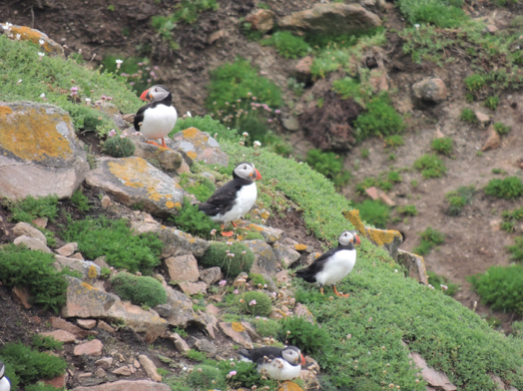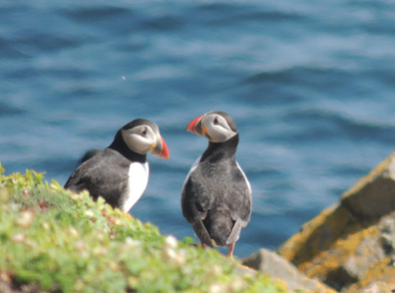The Atlantic Puffin: The Colourful "Clown of the Sea".
The Atlantic puffin, also known as the common puffin, are charismatic seabirds and members of the auk family. Although small in stature, these tough little birds spend the majority of the year in the Atlantic Ocean, only coming to shore to breed. It’s easy to see why these birds are so popular – with their vibrantly coloured beaks which has been described as "clown-like". As such, they are a target of many birdwatchers, photographers and tourists alike.
The Atlantic Puffin ( Fratercula arctica ) are smaller than you may expect, with an average height of only 20cm. There may be a misconception that they are larger as they have a similar look and upright stance to penguins. However, when trying to spy these birds from afar through a binoculars or telescope, it soon becomes evident how little they are! Puffins are clumsy flyers, and don’t travel very far on land. But despite this they are excellent and graceful swimmers, using their webbed feet to steer and their wings to stroke.
The habitat of the Atlantic puffin ranges from the northeast coast of the United States and Canada to Iceland and the Northwest of Europe, including the UK and Ireland. They have even been recorded as far south as Morocco during the winter.
Their winters are spent at sea, where their characteristic bright colours fade to become grey and dull. Puffins return to coastal locations and rocky outcrops between April and September to breed, where their beaks and feet regain their bright colour. Puffins lay a single egg in a burrow, which they either dig themselves, or steal from rabbits or even Manx shearwaters.
Puffins mate for life. Although it is unknown whether mates encounter each other at sea during the winter months, they partake in a bonding ritual known as billing upon returning to shore. The process of billing involves the puffins rubbing their beaks together which looks very affectionate. Puffins raise one chick per breeding season but have often been seen to take a 2 year break due to stress. Chicks are robust, grey and fluffy, and are commonly referred to as "pufflings". Both parents care for and raise their young, with one standing guard at the entrance of the burrow while the others goes to sea to fish.
Puffins in Ireland can mainly be found on the jagged and wild west coast, in places such as the Cliffs of Moher and The Skellig Islands. They can also be found in a few locations along the east coast such as the Saltee Islands. Puffins favour islands, outcrops and cliffs as they are away from predators such as rats. An exception of this is Great Saltee island, which has a major invasive rat problem, causing the puffin population there to decline.
Read more about the invasive brown rats and Manx shearwaters here.The Atlantic puffins European population is currently endangered and has a worldwide status of “vulnerable” according to the IUCN. Despite conservation efforts, numbers are continuously declining. Birdlife International have predicted that numbers are estimated to decrease by 50%- 79% during 2000-2065. So why is there such a drop in numbers?
Recent studies have linked this to the puffins being too exhausted to breed after their long journey across the Atlantic – Ireland and the UK are amongst outermost reaches of their habitat. After such a long journey, they tend to focus on resting themselves rather than breeding and raising a chick. Climate change is another contributing factor. The main diet of puffins in Ireland are sand-eels. Due to rising sea temperature, sandeels are going further and further north, leaving less food for the puffins to eat.
As the most pressing threats to puffins are climate change and exhaustion, what can we actually do to help? Besides reducing our carbon footprint, the most helpful thing we can do is to respect the puffins during breeding season. It can be tempting to get up close and personal with these sweet little birds, but what we don’t see is the aftermath of our disturbance. If we pause a little too long while watching, or get a little too close, worst case scenario is the abandonment of a chick. Puffins have a long life span, so won’t risk their own lives for the sake of a chick when they will have many more years of breeding. Staying too long near a puffin’s burrow can also leave the puffin open to Kleptoparasitism – larger birds will swoop in and steal their food if they cannot get into their burrows quickly enough.
If you wish to go and see puffins this summer, that’s great! They are beautiful little birds. But please remember to not get too close and try and avoid staying longer than 10 minutes at one site. Also look where you step – puffins burrow underground, and if the soil is soft enough they are in danger of collapsing and trapping them underground. Don't forget that you can also contribute to their conservation by recording them through the Observers App - count how many you see and fill out a seabird recording form to help us monitor these facinating seabirds through citizen science.
We are very lucky to have these beautiful little birds in Ireland, so let’s do our best to conserve them and keep them here.
References :
BirdLife International 2015. Fratercula arctica . The IUCN Red List of Threatened Species 2015: e.T22694927A60110592
SHARE THIS ARTICLE

















